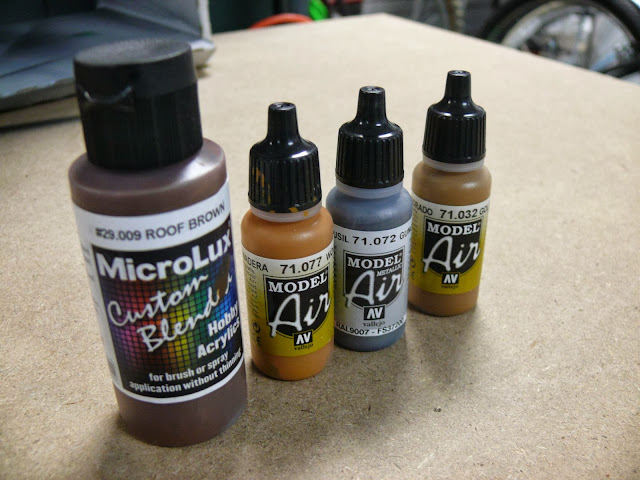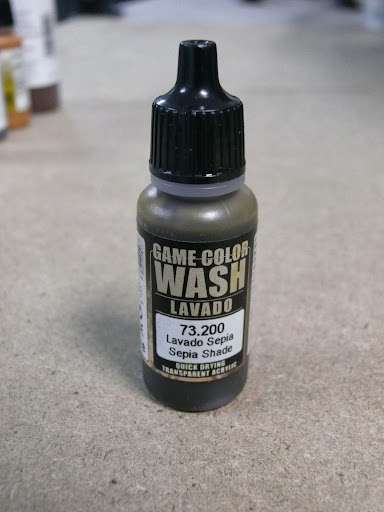Glad you like the result.
I can elaborate a bit on the wood effect... The forums are full of terrific examples with detailed explanations - most of which have eleventy six steps ending with "simple"! I'll add my method to the pile...
Real wood has tonal depth... I need to replicate that using different layers of color. Firstly, I always prime everything. No matter what. I used a rattle can of Tamiya gray primer, but I'm not too particular about the brand I use.
The Vallejo Air paints are terrific. No need for a dope like me to carefully replicate multiple blends of colors to pass properly through my cheap airbrush. The other nice thing is that the good folks over at MicroMark commissioned Vallejo to produce "MicroLux" acrylic versions of the most popular Floquil railroad colors that were going to disappear shortly. Many of these colors lend themselves nicely to period sailing ships. Several of the most used colors are made available in the larger 2oz bottles.

For all of the wood elements I start with a foundation coat of Vallejo Air "Aged White" applied with an airbrush. This gives the piece the underlying bright tone. At this point it would be normal to switch over to an oil based paint to add the next layer of darker wood tone. In this case I was able to use Vallejo Air "Wood" applied with a brush. No need to switch over to smelly oils and thinners with much more onerous cleanup. Since it is pre-mixed airbrush paint, the Vallejo Air paint will go on nice and thin and I can layer it up to get a good medium tone while still allowing the underlying bright tone to show through. The next layer was Vallejo air "wood" mixed with a small tad of MicroLux Air "Roof Brown". I just did one thin coat with a brush to give a final, deeper tone.
The last step is the critical part...
There have been many great ideas that have moved the human race forward through time. The wheel was a nice start... steam engines... the first airplane... landing on the moon. Penicillin was good too. But the guys in the white lab coats at Vallejo really made a contribution when they came up with this stuff:

Acrylic wash that can be applied over acrylic paint. No smell, no need to mix paint and thinner... water clean up. This stuff belongs in the pantheon of great human achievements. As a final step, I smear this sepia wash over everything and immediately wipe it off with a soft cloth or cotton swab. Pretty similar to using a stain with wood. This final step imparts a nice woody sheen across everything and helps the colors blend. I should note that with Acrylics, I always allow the paint to dry overnight before adding the next layer. I did, however, wait only 20 minutes or so to add more paint within the same medium color layer whenever I was trying to deepen the tone.
Simple!
The deck was done similarly, but with only two layers. I varied the colors on the planking between Vallejo Air Aged White mixed with Vallejo Air Wood, Vallejo Sepia wash, and Vallejo dark wash. I did add a bit of Vallejo Air "Earth" to the Aged White on the first layer just to give the entire deck a slightly deeper tone. The sepia wash was applied and wiped off to give the nice wood-like sheen. A dark gray .03mm pen was used for the lines between the planks.
For whatever else it may be worth, the camboose and anchor were both primed then air brushed with Vallejo Air "Gun Grey" with a thin coat of MicroLux (Vallejo Air) "Engine Black" over the top. Some fine sandpaper was then used to expose the underlying gun grey along some of the edges. The chain pump sprocket wheel was painted with gun grey and doused with the dark Vallejo wash.
The stanchions are brass micro-tubing with the smallest PE eyelets from Jotika inserted in the ends. The tube gets pinched when snipped, but the tip of a common push pin will open up the end just fine.
I haven't done the spar deck yet - I can try to document the steps a little better.
I should note that the color of the chain pumps is not authentic... In fact, I have no idea how they were painted in 1812. Likely colors would be black, white, red, or natural wood. I wanted these pumps to look interesting, but not stand out too much on the deck. I'm not using red anywhere else on the deck, so that was ruled out. The red/brown of the gun carriages was considered, but tossed since it would look like a shortcut. There were already several black items on the deck, so I ditched that idea. I had mixed up a test "mahogany" color by blending roof brown and red with the idea of using that in the captain's suite for the paneling. I elected not to go with that, so I went ahead and air brushed that color on the chain pumps. Gives a nice neutral color without standing out too much or blending in too much... Purely artistic license.
Thanks again for staying interested in my efforts!
Evan